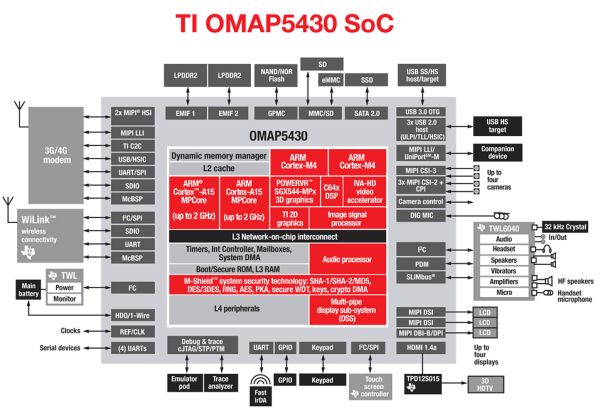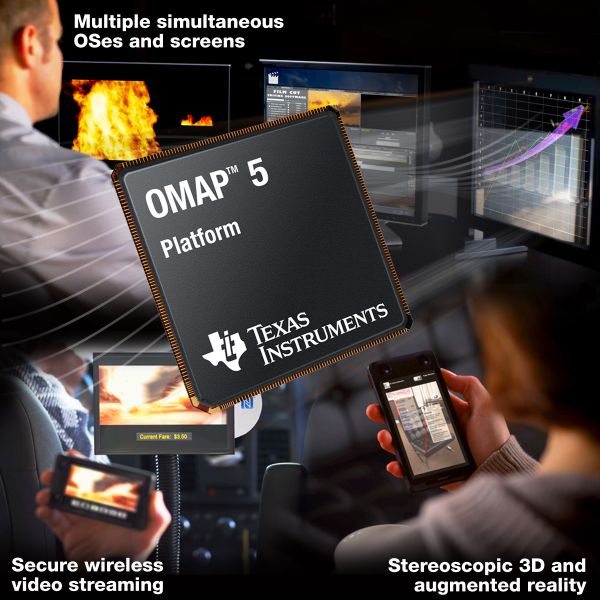TI Reveals OMAP 5: The First ARM Cortex A15 SoC
by Anand Lal Shimpi on February 7, 2011 8:59 PM EST- Posted in
- Smartphones
- OMAP
- Arm
- TI
- Cortex A15
- Mobile
- SoCs
TI sure does have impeccable timing. Not 12 hours after we published our LG Optimus 2X and NVIDIA Tegra 2 review, complete with a discussion of the 2011 SoC space, did TI announce its OMAP 5 SoC.
OMAP 5 will go into production in the second half of 2011 and ship in phones during the second half of 2012. It’s a 28nm SoC with significant architectural upgrades compared to the OMAP 4.
While the OMAP 4 integrates a pair of ARM Cortex A9 cores, OMAP 5 features two ARM Cortex A15 cores. TI already announced that it was ARM’s first licensee of the Cortex A15, so the OMAP 5 announcement is not too surprising.
The ARM Cortex A15 cores can run at speeds of up to 2GHz, although specific frequencies will depend on the OEM implementation. At 2GHz TI claims the pair of Cortex A15s should be 3x the speed of the 1GHz Cortex A9s in the OMAP 4330. At the same clock speed, TI is boasting a 50% performance advantage from the A15 over the A9.
With the OMAP 3 TI had a 256KB L2 used by its single Cortex A8. The OMAP 4 quadrupled L2 cache size to 1MB and shared it among both of its Cortex A9s. TI’s OMAP 5 doubles L2 cache size to 2MB, operating at the CPU clock speed, and it’s once again shared by the SoC’s two CPU cores (in this case Cortex A15s). The OMAP 5 retains the same dual-channel LPDDR2 memory interface from the OMAP 4.
Architecturally we still don’t know much about what makes up a Cortex A15, although I suspect we’ll get more of that in the coming months. Update: It looks like ARM has released some info on the A15. It appears to be a wider, deeper, even more OoO architecture. More on this later.
In our Tegra 2 review I mentioned that the transition from ARM11, to Cortex A8 and now to Cortex A9 left us with a generational performance improvement each step of the way. The move to A15 will be no different. ARM’s Cortex A8 went mainstream in the performance segment in 2010, Cortex A9 will do the same in 2011 and with any luck we’ll see A15 before the end of 2012. It’s this sort of yearly cadence that ARM and its partners must keep up in order to really catch up and surpass what Intel has been promising with Atom. Atom came out in 2008 and it won’t be until late 2012 that its architecture is truly refreshed. For a company that survived the mistakes of NetBurst, Intel doesn’t seem to have learned much of a lesson there.
In addition to its dual Cortex A15 CPUs, the OMAP 5 will feature two ARM Cortex M4 cores as well. The M4 isn’t very useful as a general purpose microprocessor, it only supports the ARM Thumb/Thumb-2 instruction sets (not the full 32-bit ARMv7-A ISA). The M4 does have a suite of signal processing extensions that can be used to accelerate audio/video encode and decode. One application of the M4s will be still picture enhancement. A goal for the next-generation of SoCs is to begin to bridge the gap between smartphone camera quality and high-end point-and-shoot and DSLR cameras. Obviously we’ll always be bound by the poor optics possible on smartphones, however there’s still a lot that can be done in hardware to improve the quality of what’s captured.
The OMAP 5 supports up to four cameras. One demo I saw Intel put together a while ago was of a smartphone with two equal resolution/quality cameras on its back. The only difference between the two was the focal length of the lens. Whenever you took a photo with the demo camera you’d actually capture the scene at two (vastly) different focal lengths. The SoC (in this case an Atom) would use the captured data to produce one image where the entire scene was in focus, with improved sharpness/detail over a single camera solution. It’s possible that OMAP 5 based smartphones may feature similar technologies and use its Cortex M4s to merge/interpolate data from the camera sensors.
As ARM’s CPUs grow in power consumption, the amount of fixed function or specialized silicon set aside to offload various tasks will increase. The Cortex A15s should be used only for those applications that absolutely need them, anything else should be offloaded.
The OMAP 5 SoC integrates Imagination Technologies’ PowerVR SGX 544 GPU, although it’s unclear how many cores will be present in TI’s implementation. Each SGX 544 core has four USSE2 pipes compared to four USSE pipes in the SGX 540, and two USSE pipes in the SGX 530. Each USSE2 pipe offers an increase in compute power compared to the old USSE pipes, however I don’t have details on specific differences in internal organization.
TI announced two versions of the OMAP 5: the 5430 and 5432. The OMAP 5430 features a 14 x 14mm PoP with LPDDR2 memory support, while the 5432 is a larger 17 x 17mm BGA package with DDR3/DDR3L support. The 5430 will likely be used in smartphones while the 5432’s larger size would be better suited for tablets.
On paper alone the OMAP 5 looks to be very powerful, but it needs to be. Also shipping in 2012 will be Qualcomm’s MSM8960 and we may see Project Denver as well. The application processor race hasn’t even begun to heat up, but it’s starting to get interesting.












39 Comments
View All Comments
Meaker10 - Monday, February 7, 2011 - link
That would be a useful application of the cameras (increasing the depth of focus), but how much do you want to bet they are just going to take bad quality 3d images instead?SPOOFE - Tuesday, February 8, 2011 - link
With support of up to four cameras, you can take Extra-DOF bad quality 3D images!sabot00 - Monday, February 7, 2011 - link
So, even when OMAP 4 isn't finished, we have specs of OMAP 5?I don't remember such forwardness with either AMD or Intel, or with nVidia or ATi.
Shadowmaster625 - Tuesday, February 8, 2011 - link
The ultra-mobile computing sector is being driven like cattle. It makes no sense for so much money to be spent in this space. Millions of spiritually devoid yuppies are spending over $100 a month (amortized) on this crap, and it serves no real purpose above and beyond what they could be getting for $20 a month. I think the phrase "spiritually devoid" is the key. These people who feel this compulsion to blow in excess of $100 a month are attempting to fill a void that will only grow larger once they become tethered to one of these things. A cheap mobile phone, a good paperback novel, and an extra $80 a month in your pocket will make anyone happier than having one of these stupid things. But I know no form of logic or rationality will stop this.strikeback03 - Tuesday, February 8, 2011 - link
Umm, I spend $23 a month for my data plan, and the phone was $200 spread over the 20 months I have been using it. The basic plan costs far more than that.MobiusStrip - Tuesday, February 8, 2011 - link
"Umm, I spend $23 a month for my data plan, and the phone was $200 spread over the 20 months I have been using it. The basic plan costs far more than that. "So if the "basic" plan costs more than that, what is YOUR plan? What's your total bill, not just the data plan? What country are you in?
Your post doesn't carry any weight when it lacks any specifics.
strikeback03 - Thursday, February 10, 2011 - link
My basic plan includes myself, my wife, and my grandmother, 700 minutes, unlimited sms/mms, and data on my line. With taxes and all it costs $135 a month. We would go lower minutes if we could but this is the lowest available. The point was that having the cheapest, least capable cellphones possible would still be ~$110 a month, so the additional cost of a smartphone is not nearly the $100 a month suggested. Maybe if I bought the newest phone at full retail price every few months and then sold it for a loss to do the same thing over again it could hit $100 a month.Western NY, USA
jharper12 - Tuesday, February 8, 2011 - link
Seriously? I'm always dumbfounded by comments such as yours, 'phones cost too much... blah blah blah.'50 years ago, did people spend $100 a month on cable? $50 a month on internet access? $17k for a new compact car? Prices rise, new services are established, and the world changes. Get over it. I spend far less money on film development than my parents did, as in, no money. My typewriter budget is also minimal compared to my grandmother, hovering at around $0 for quite some time.
Who are you people? Are you a member of an older generation? Bitter, perhaps, that technology has progressed so far, but you no longer have a reason to stay up to date now that you are retired and on a fixed income?
Seriously, tell me who you are, I am really curious. First off, I pay $45 a month for my unlimited smartphone plan. It's my home phone, portable phone, internet on the go, camera, GPS unit, fax machine, portable game system, e-book reader, calendar, note system, document holder, and general work tool. I don't bring a good paperback novel with me, I bring 213 books with me, want to guess what that would cost in checked bag fees?
So, Mr., "serves no real purpose above and beyond what they could be getting for $20 a month," where can I get all that functionality for $20 a month? I can guarantee you, that I am far more frugal than you are... I own my home, I am working on buying my first rental property, and I live off of about $1,000 a month. Did I mention that I'm 26? I have an awesome job, where I travel non-stop that pays well above $1,000 a month, but guess what? I wouldn't have that job if it wasn't for my smartphone, it literally enables me to do my job.
Ohh, and did I forget to mention that my company pays for my smartphone? Actually, they pay a little more than I pay, so I make money on my smartphone plan.
Last but not least, this "spiritually devoid" techie used his smartphone as a bible in church on Sunday. Seriously, it's nice to have my bible with me while I travel without having to lug a large book around the country.
NCM - Tuesday, February 8, 2011 - link
Hey! Easy with your stereotypes about older generations there sonny! ;-)Luddites come in all ages and flavours, as do techies.
Me, I'm still awestruck at the computing power I have in my pocket, available for my use at any time. It makes my work easier and more effective, helps to stay in touch with friends and family, brings me information from all over the world, holds a big chunk of my music...and even lets me read Anandtech.
When i was a kid this was the stuff of sci-fi and Dick Tracy comic strips (the famous "wrist radio").
Not that I don't periodically get the sensation of being bent over by my cell company, but fundamentally it's worth every penny.
synaesthetic - Tuesday, February 8, 2011 - link
I'm glad that T-Mobile hasn't tried to ream me in the posterior just yet...I feel the same way, sometimes, playing with my smartphone, it's like living a William Gibson novel. :D